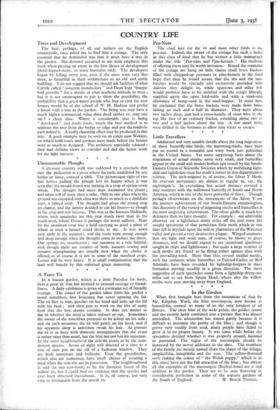COUNTRY LIFE
Trees and Development The best, perhaps, of all our writers on the FAT] sh countryside, once asked me to find him a cottage. The only essential that he demanded was that it must have a tree in the garden. His demand occurred to me with emphasis this week when passing an estate in the first throes of development (devil-lopped-ment, as some humorist said). The developers began by felling every tree, even if the trees were very fine trees, as beautiful in their architecture as an old and noble building. I do not suggest that we should ask builders of what Carlyle called " concrete mendacities " and Dean Inge "bunga- loid growths " for a mystic or even aesthetic attitude to trees ; but it is not extravagant to put to them the possibility, the probability that a great many people who buy or rent the new houses would be of the school of W. H. Hudson and prefer a house with a tree in the garden. l'he living tree may have a much higher commercial value than dead timber or, may one say ? a clean slate. Where a considerable area is being " developed " and roads made, much the best method is to separate the tree from the hedge or edge and put the roadside path behind it. A really charming effect may be produced in this way. A good example may be seen on an estate near Woking, on which both roads and gardens were made before the houses were so much as designed. The architects especially rejoiced ; they had definite views to consider and did the better work for the light harness.


















































 Previous page
Previous page